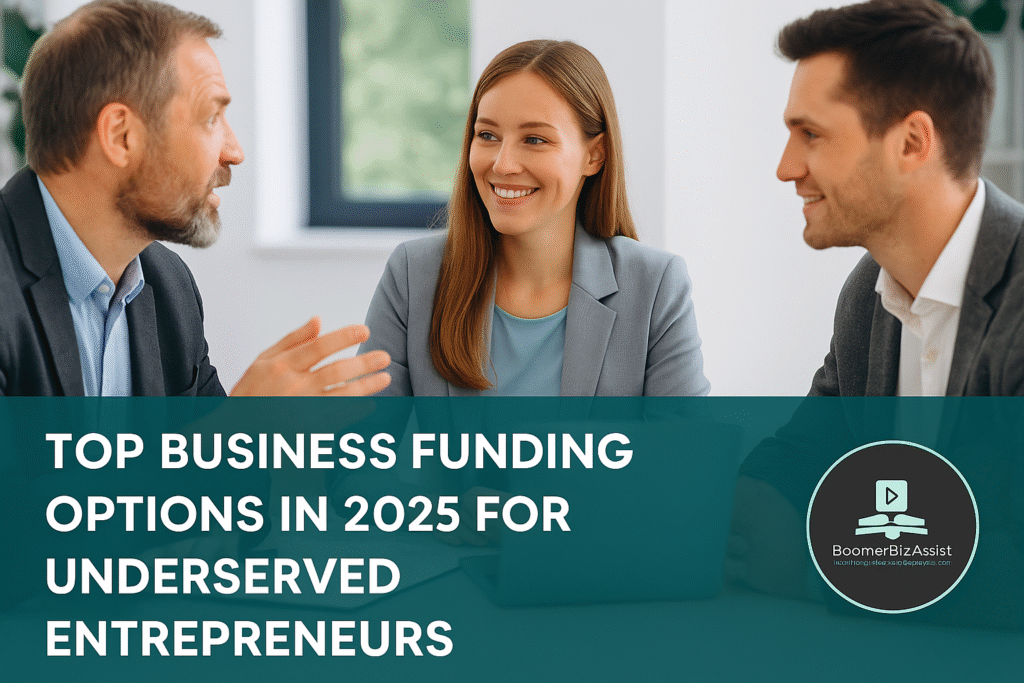Getting access to funding is often the biggest barrier between a great business idea and a thriving enterprise. For underserved entrepreneurs—including women, people of color, low-income founders, veterans, and late-career pivoters—this challenge is even more pronounced. Traditional banks often say “no” due to limited credit history, low collateral, or a lack of industry networks.

But 2025 is opening new doors. From mission-driven microloans to creative funding platforms, today’s business funding ecosystem is finally shifting toward inclusivity and innovation.
This in-depth guide breaks down the most relevant and accessible funding options for underserved entrepreneurs, along with practical tips on how to pursue them—even if you’re just starting out.
Why Underserved Entrepreneurs Need Different Funding Strategies
Access to capital has historically favored entrepreneurs with wealth, assets, or existing networks. But if you’ve been self-funding, working from home, or launching as a solopreneur, you may have been excluded from traditional paths.
Underserved founders often face:
- Higher denial rates from banks and SBA lenders
- Lower access to angel investors or venture networks
- More difficulty producing “standard” business documentation
As a result, many are left wondering where to turn—or worse, they give up.
The good news? Funding opportunities in 2025 are more diverse than ever, with new models specifically designed for people who’ve been locked out of the system.
1. Microloans from Community Lenders (CDFIs)
Community Development Financial Institutions (CDFIs) are non-profit lenders who specialize in helping underserved business owners. They’re ideal for first-time founders with limited credit or collateral.
✅ Loan amounts typically range from $500 to $50,000
✅ Flexible terms and low interest rates
✅ Focus on character and community impact, not just credit scores
Top CDFIs to explore in 2025:
- Accion Opportunity Fund
- LiftFund
- Grameen America (for women entrepreneurs)
2. Local and National Grant Programs
Unlike loans, grants don’t need to be repaid. They’re highly competitive but well worth the effort—especially if you have a strong mission or impact-focused model.
Types of business grants available in 2025:
- Federal small business grants via Grants.gov
- State and city-level grants for economic development
- Nonprofit and corporate grants for women, minorities, and veterans
Examples include:
- The Amber Grant (for women-owned businesses)
- Hello Alice Grants
- USDA Rural Business Grants
Pro Tip: Get grant-ready first. Check out our internal guide on how to prepare your business for grant applications.
3. Crowdfunding: Build Community & Raise Capital
Crowdfunding isn’t just for tech startups. Platforms like IFundWomen, Kiva, and GoFundMe allow entrepreneurs to raise funds from people who believe in their mission.
Types of crowdfunding:
- Donation-based: Supporters give money with no expectation of return (e.g., GoFundMe)
- Reward-based: Backers get early products or perks (e.g., Kickstarter, Indiegogo)
- Debt-based: You repay backers with low interest (e.g., Kiva)
📌 For impact-driven, community-oriented startups, crowdfunding is both a funding source and a marketing strategy.
Check out: Kiva’s zero-interest loans for underserved entrepreneurs
4. Peer-to-Peer Lending Platforms
P2P lending is growing in popularity among entrepreneurs shut out of banks. These online platforms connect borrowers directly with individual investors willing to fund small businesses.
Popular platforms in 2025:
✅ Lower barriers than traditional banks
✅ Great for mid-sized capital needs ($5,000–$40,000)
✅ Quick applications and funding decisions
Always compare terms and verify the credibility of the platform. Not all P2P lenders are created equal.
5. Startup Incubators with Funding Support
Business incubators are more than coworking spaces—they offer mentorship, workshops, and often access to seed funding or pitch competitions.
Incubators supporting underserved groups in 2025 include:
- Founders First Capital Partners
- DigitalUndivided (Black and Latina women founders)
- Veteran Women Igniting the Spirit of Entrepreneurship (V-WISE)
Incubators often lead to:
- Microgrants
- Pitch contest winnings
- Strategic partnerships and press exposure
Learn how to maximize an incubator experience in our guide: How to Leverage Business Incubators as a First-Time Founder
6. SBA Microloans and 7(a) Community Advantage Loans
The U.S. Small Business Administration (SBA) has traditionally served established businesses, but in 2025, their programs are expanding to reach early-stage entrepreneurs.
- SBA Microloans – Up to $50,000 with counseling and flexible terms
- SBA Community Advantage Loans – For underserved markets via mission-focused lenders
Apply through local SBA-approved intermediaries. Visit SBA Lender Match to get connected.
7. Business Credit Cards & Alternative Lines of Credit
If you have decent personal credit and need flexible cash flow, a business credit card or revolving credit line could be a lifeline—especially for covering early-stage expenses like marketing or inventory.
In 2025, newer fintech options like Brex, Ramp, and Bluevine are offering tools that work well for solopreneurs and new LLCs.
Caution: Always use credit for growth, not just survival. It’s easy to rack up debt quickly.

8. Strategic Partnerships & Vendor Financing
Not all funding comes from banks. Some of the best startup capital comes from relationships:
- A vendor may extend 30–60 day terms
- A partner may co-fund a pilot program
- A local nonprofit may pay your way into a training or marketing campaign
These relationship-based funding options often fly under the radar—but they can be powerful for building without loans.
📌 We cover these in more detail in Creative Ways to Fund a Business with No Money
9. Pitch Competitions for Niche Entrepreneurs
In 2025, dozens of organizations are sponsoring pitch contests to boost visibility and access to funds for mission-aligned founders.
Win prizes from:
- NAACP x Hello Alice Pitch Grants
- Black Ambition (Black and Hispanic founders)
- Cartier Women’s Initiative
These events offer exposure, mentorship, and cash prizes from $5,000 to $100,000 or more.
Don’t just watch—practice pitching and participate. Your story matters.
Final Tips for Getting Funded in 2025
Whether you’re applying for a grant or planning a crowdfunding launch, here’s how to increase your success:
✔️ Get Grant-Ready
Have a basic business plan, mission statement, and projected financials ready. Use our free blog on writing a simple business plan in 7 steps to start.
✔️ Build a Digital Presence
Funders will look you up. Even a one-page website or active LinkedIn profile makes you more credible.
✔️ Join Free Training Events
BoomerBiz Assist offers free webinars to help you understand and apply for startup funding and tech tools. Learn more at BoomerBizAssist.com.
Take the Next Step with BoomerBiz Assist
Ready to turn your business idea into action? BoomerBiz Assist provides free webinars, DFY startup toolkits, and clear launch pathways designed for underfunded entrepreneurs.
Whether you’re starting over or just getting started, we’re here to simplify the journey.
Visit BoomerBizAssist.com and take your next confident step today.
